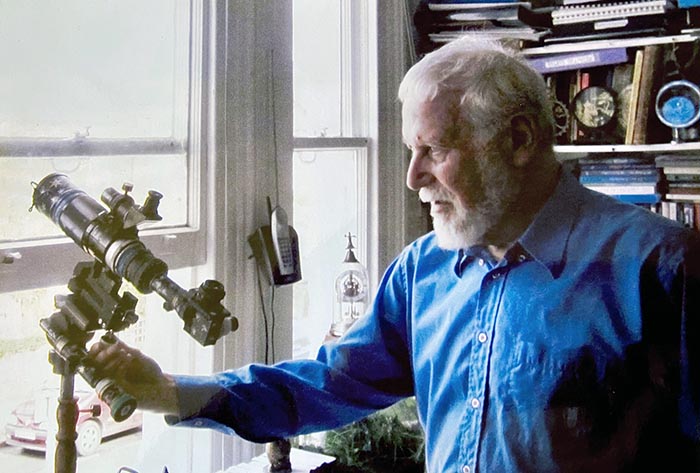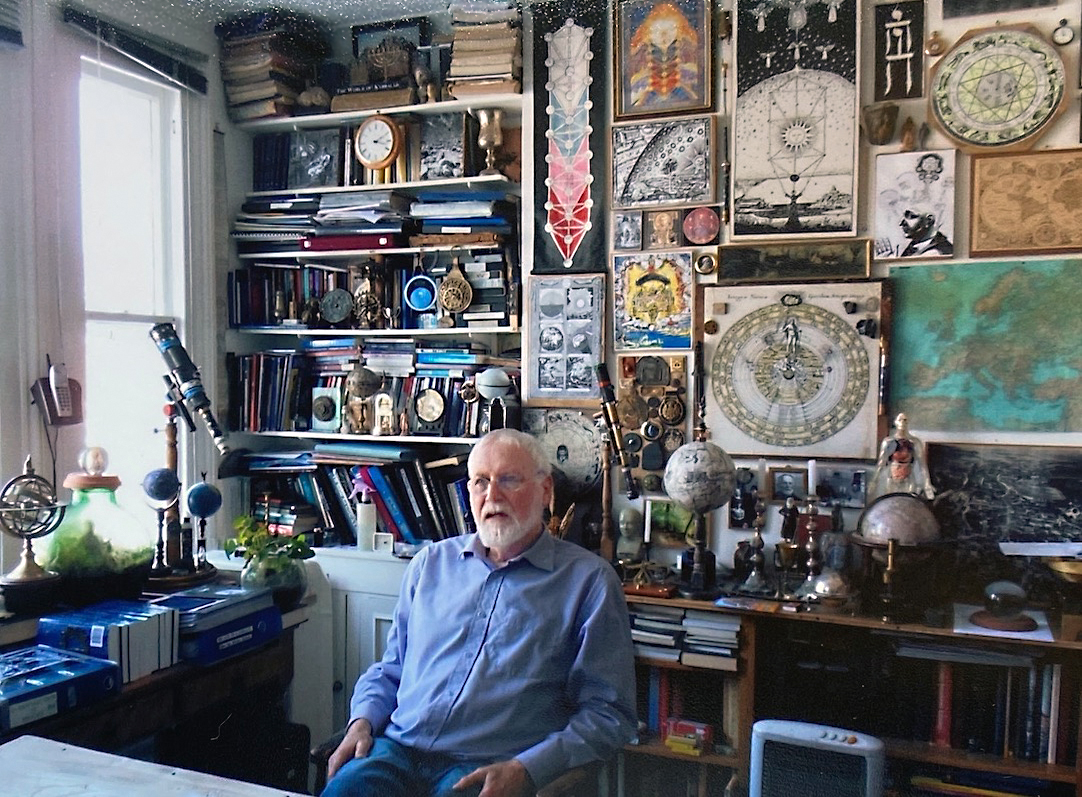News & Views
Z’ev ben Shimon Halevi / Warren Kenton (1933–2020)

Z’ev ben Shimon Halevi in his ‘room’ in London. Photograph: courtesy Joanna Lapage-Browne
Z’ev ben Shimon Halevi, also known as Warren Kenton, died on 21 September 2020 at the age of 87. He is survived by his wife of 33 years, Rebekah. A man of wisdom and spiritual stature together with a sense of humour and a practical nature, he used his long life to the full in his task of updating and clarifying the tradition of Kabbalah for our times.
Born into a traditional Jewish family in London on 8 January 1933, he spent much of his childhood in the area around High Wycombe where his family moved to avoid the bombing in the Second World War. Here in the Chiltern hills, the rich history of the area, the beauty of the fields and woods and the impact of the war left a deep impression on him.
He moved to London, which he explored extensively with his love of history, and studied at St. Martin’s School of Art and the Royal Academy School. His training as a graphic artist and a book illustrator came to good use later when he selected images for the revised editions of his books. He said that in art school he learnt to see, which made him think creatively rather than academically. He also drew human faces and observed character, which taught him about psychology. This became useful later when doing horoscopes.
He chose to spend his National Service first in mental hospitals and then in a large London teaching hospital, during which time he observed human psychology in life and death at first hand. He then returned to his love of art, finding employment in theatre workshops. His time working with these gave him the practical skills to improvise and invent from all manner of materials, an aptitude which brought him much pleasure, continuing into his old age and evident in the extensive collection of tools and raw materials he left behind.
His early enthusiasm for telescopes developed into an interest in astrology and esoteric teachings. He went on to explore the inner dimensions of various religions and philosophies, but soon realised there was only one teaching, and that was universal. It was in a Gurdjieff–Ouspensky school that he met a friend who instructed a small study group in astrology and introduced him to Kabbalah and the Tree of Life. He recognised and remembered the Tree of Life, and saw its precision in explaining how the microcosm and the macrocosm came together. He started to look deeper into his own Jewish heritage and found hidden treasures in its traditions and vast mythology. Teaching and writing about Kabbalah became his life’s work.

Z’ev ben Shimon Halevi in his ‘room’ in London. Photograph: courtesy Joanna Lapage-Browne
Revival of Kabbalah
.
Halevi began to write on Kabbalah in the early 1970s while living in a small flat near to Holland Park, setting out the four worlds of Action, Formation, Creation and Emanation in terms of the body, psyche, spirit and divine elements in a human being. He made a point of studying what he called parallel ‘schools of the soul’ (For more on this, see his Beshara Magazine interview), and of meeting other teachers, which enriched his understanding of the way that the teaching is matched to different cultures and times.
His specific calling was to update the tradition of Kabbalah. He recognised the need to clear away the complexity and mystification that had accumulated over many centuries and to apply its universal principles to topics such as psychology, astrology, religion and science. His particular contribution was to extend and reformulate the Tree of Life diagram, which he called Jacob’s Ladder, describing and filling in the triads and setting out the Tree of the Psyche in great detail. His work on the Jacob’s Ladder diagram revealed how the physical, psychological, spiritual and divine worlds interact so that we, as Divine organs of perception, might ‘aid God to behold God’. His legacy is an integrated system and a contemplative working method.
While Halevi passed on the tradition of Kabbalah in his writings, he also ran study groups and meditations in his iconic ‘room’, filled with diagrams, sacred objects and bookshelves of esoterica – and of course his beloved telescopes. The same ‘room’ moved with him though all his various homes. His teaching was marked by its relevance to life experience and history, together with the vital element of humour, a tradition deeply embedded in Jewish culture. His telling of jokes is memorable.
Over 50 years, he taught groups, ran workshops and lectured in other schools such as the Theosophical Society and the Temenos Academy, of which he was a Fellow. He taught in many countries including Europe, North and South America, Japan, Israel, Egypt, Australia and South Africa, and also led pilgrimages to sacred sites. Halevi’s school, the Kabbalah Society [/], is also called the Toledano Tradition, which refers to its lineage from classical Spanish Kabbalah and reflects the time in medieval Toledo when Jews, Christians and Muslims lived in peace and exchanged ideas.
Halevi advised many people privately, often using their horoscopes to gain insights into themselves and their life situations using his discerning knowledge of astrology and Kabbalistic principles. Central to his teaching is that the practice of Kabbalah is through personal experience and insight.
His seventeen books on Kabbalah, including works on astrology and a novel, have been translated and are available as foreign editions in sixteen different languages. The revised editions of his books are also available as eBooks.
Halevi was much loved by his many students and friends worldwide, who will miss him greatly. The world has lost a visionary wise one.
To read our interview with Z’ev Ben Shimon in Issue 3, click here.
For further information about The Kabbalah Society and books by Z’ev ben Shimon Halevi, click here [/].
More News & Views
Don’t Take It Easy
Richard Gault is inspired by Michael Easter’s book The Comfort Crisis and explores the idea of ‘misogi’ during a 600-mile walk across Scotland
Book Review: ‘The Serviceberry’
Martha Cass contemplates the message of a new book by Robin Wall Kimmerer that advocates ‘an economy of gifts and abundance’
Book Review: ‘Conversations with Dostoevsky’
Andrew Watson engages with an innovative new book by George Pattison which explores Dostoevsky’s relevance in the contemporary world
Thich Nhat Hanh & the Poetry of Engaged Buddhism
Philip Brown presents the poem ‘Recommendation’ and comments on the potential of contemplative art to foster compassion
Introducing… ‘Perfect Days’ and ‘Nowhere Special’
Jane Clark watches two films with a contemplative theme
Book Review: ‘Irreducible: Consciousness, Life, Computers and Human Nature’
Richard Gault reviews a new book by Federico Faggin, one of the leading lights of the science of consciousness
FOLLOW AND LIKE US
——————————————
——————————————
——————————————
If you enjoyed reading this article
Please leave a comment below.
Please also consider making a donation to support the work of Beshara Magazine. The magazine relies entirely on voluntary support. Donations received through this website go towards editorial expenses, eg. image rights, travel expenses, and website maintenance and development costs.
READERS’ COMMENTS
FOLLOW AND LIKE US
0 Comments